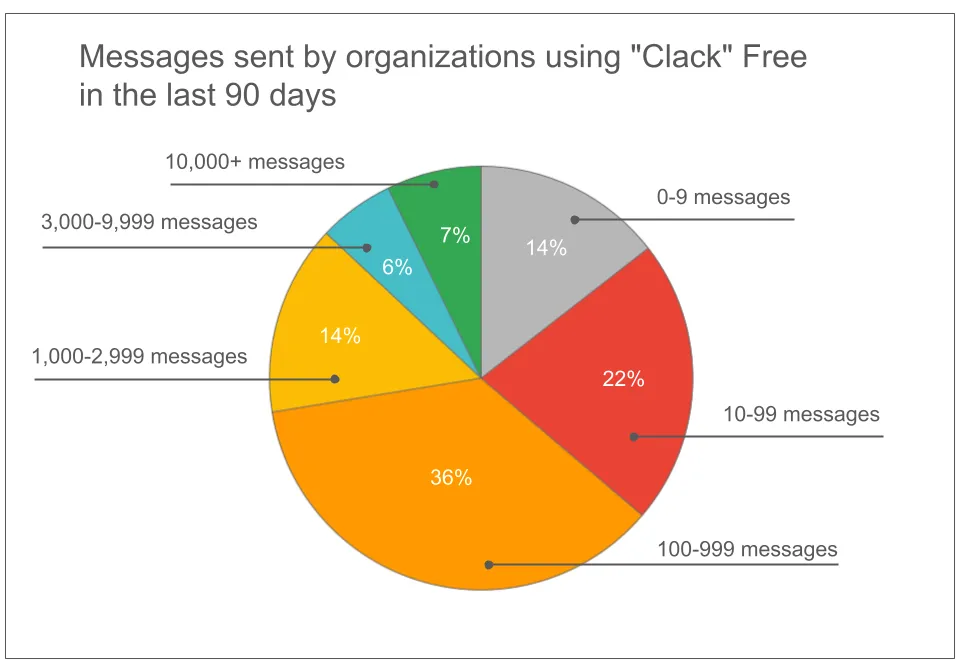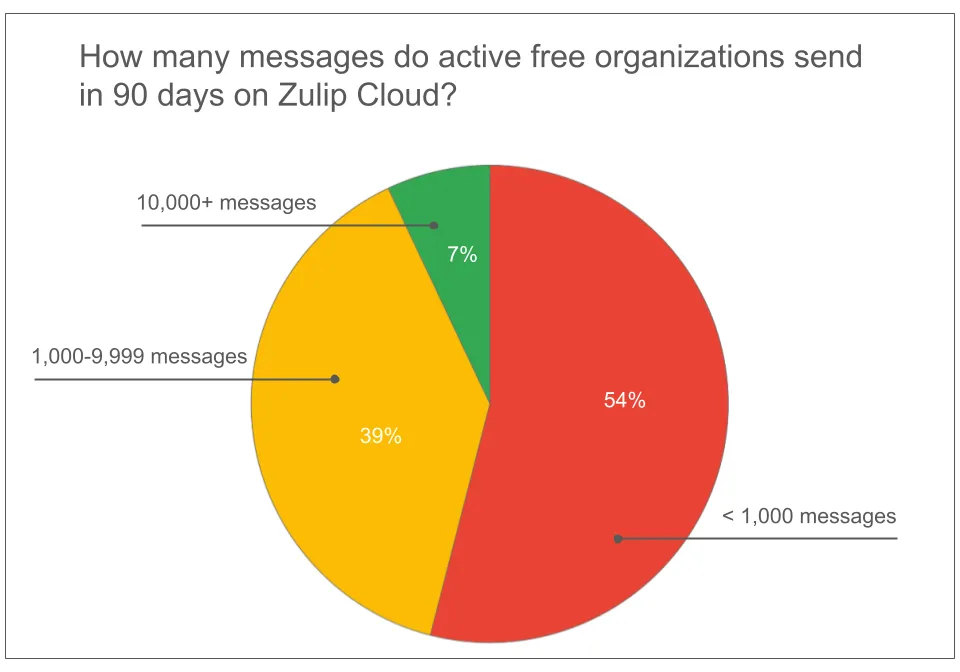Why Slack’s free plan change is causing an exodus
 Tim Abbott
Tim Abbott On July 18, 2022, Slack announced that starting September 1, search history for organizations on Slack’s Free plan will be limited to just the past 90 days of message history.
Instead of a 10,000-message limit and 5 GB of storage, we are giving full access to the past 90 days of message history and file storage. — Slack’s announcement
At first blush, this might look like a minor policy tweak. But it is in fact a dramatic change that makes Slack’s free plan untenable for many organizations, including ones that have been happily using Slack’s free plan for years.
God dammit @SlackHQ ! This change to 90 days REALLY SUCKS for SMALL teams!!!! By doing this you have OBLITERATED small family projects or other LONG term but brief sync up groups! I have recommended Slack for almost any project! I can’t do that anymore… :-(
– James Bennett Saxon (@ijames), August 23, 2022
Understanding the impact: the numbers
Slack is marketing the change as a “simplification”, which will benefit most active teams:
The majority of our active free teams will have access to more of their message history with the new 90-day limit compared to the previous limit. — Slack’s announcement
Nevertheless, social media is abuzz with messages from users upset about this change, and one would be hard-pressed to find any who are excited about it. Moreover, many teams have decided to abandon Slack altogether.
We know this because we run Zulip, an open-source alternative to Slack. Organizations migrating to Zulip can import message history from Slack and other popular team chat tools. We have seen data imports from Slack into Zulip Cloud increase an incredible 40x since Slack’s July 18 announcement! And this is still early days, as the exodus may well accelerate when users start experiencing the impact of Slack’s policy change in September.
What is an active team?
If, as Slack claims, “the majority of [Slack’s] active free teams” benefit from the change, why would Slack’s free plan users be leaving in droves?
There’s one unanswered question that is central to understanding Slack’s marketing claim: what exactly is an “active” team?
Let’s say you’ve got a team chat app called “Clack” that’s changing from a 10,000 message access policy to a 90 day message access policy, with the following usage stats:

Just 7% of teams will benefit from Clack’s policy change, but perhaps inactive teams (the grey segment) should be excluded from the analysis, bringing the number all the way up to… 8%. Or perhaps only teams sending about one message a day or more should be considered active (excluding the red segment) — in that case, 11% of active organizations would benefit.
But Clack’s marketing team isn’t happy with that! They ask the analytics team what can be done, and a new analysis is proposed: if you only count the teams that send 3,000+ messages in 90 days as “active” (just the blue and green segments), the press announcement can state that more than half of Clack’s free organizations will benefit from the change!
We were not in the room when Slack put together their announcement, but it seems plausible that Slack had its own version of the Clack conversation above. The result would be a definition of “active” specifically crafted to describe teams that are likely to send 10,000 messages in the last 90 days.
Do you think most Slack teams on the free plan are active enough to send 10,000 messages every 90 days? That’s 111 messages every single day, or 156 every weekday!
Data insights from Zulip Cloud
While we don’t have access to Slack’s internal metrics, we can share some data about users of the Zulip Cloud Free plan. Zulip’s free plan has a 10,000 message history limit, just as Slack’s did prior to their policy change.
On Zulip Cloud, 93% of active organizations on the free plan would lose out from a change to a 90-day message history policy, where “active” is defined as human users sending 30+ messages in the past 30 days. Most organizations would be able to access less than 10% of the messages that were previously available to them.

Slack’s press release paints a very different picture — one where the green segment is the majority of the pie chart. The exact level of activity for teams using Slack’s free plan likely differs somewhat from Zulip Cloud. But the most realistic way for that green segment to be the majority of Slack’s pie chart is if Slack defined “active free teams” to exclude most teams that are actually using their free plan.
In conclusion, our data strongly suggests that Slack’s policy change is likely to make their free plan much worse, not better, for the majority of teams using it.
Understanding the impact: the stories
Among the stories we’ve been hearing from users, a few categories of organizations jump out as being hurt the most by Slack’s free tier change. These are groups that are severely impacted by losing their older message history, while lacking easy access to funding to afford a paid plan.
- Researchers, educators, and students. Research initiatives often span years of work, and academic collaborators depend on being able to reference prior discussions. For educators and students, 90 days won’t even get them through a single semester.
Not a fan of the change to a 90 day limit on @SlackHQ. I have a small group, but we keep track of multi-year long efforts. We haven’t hit 10k messages, but losing things after 90 days makes a huge difference. Any folks out there in similar positions have suggestions?
— Karin Sandstrom (@karinsandstrom), July 28, 2022
- Community groups. Community organizations, volunteers, interest clubs, and other groups come together on team chat. They often have no money to pay for software, and will lose out on Slack’s new free plan.
On Sept. 1st 2022 @SlackHQ is changing the rules for the free plans from ” you can see only the last 10k messages” to “only the messages of the last 90 days” and try to market this as an advantage. IMHO a massive negative impact for a lot of communities relying on the free plan.
— Markus Hippeli (@AngryAgilist), July 23, 2022
- Open-source projects. Chat history can serve as a valuable knowledge base and transparent record of decision-making for open-source projects. Limiting chat history to 90 days destroys this value.
#opensource twitter - how are you reacting to @SlackHQ hiding messages after 90 days? We use #slack daily for communicating with ~70 member #pyam community. This change kills our ability to discuss tips, proposed features, etc. Preferred alternatives?
https://pyam-iamc.readthedocs.io/en/stable/
— Matthew Gidden (@mattgidden), August 10, 2022
These categories are exactly the sorts of public interest groups which Zulip has long supported by sponsoring free or heavily discounted Zulip Cloud Standard hosting. It is sad to see Slack pulling the rug out from under them.
Losing private message data
One aspect of moving off Slack has been causing heartbreak for many folks who reach out to us to migrate their data to Zulip: losing private message history.
Slack provides an automated export tool, and exports include full public channel message history, including older messages that would otherwise be unavailable on the free plan. (We have no reason to think that would change on September 1.)
However, Slack’s policies do not allow organizations on the Free or Pro plans to export their private channels and private message history. We have even heard from our customers that a workspace that upgrades to the Business+ plan in order to immediately export their non-public history may have their export request denied.
Why Zulip will not move to a time-based message history limit
At Zulip, we believe that:
- Our users should have full control over their data. Zulip is 100% free and open-source software, so you are never locked into a proprietary tool. You can export all your data with our high quality export and import tools; we will never hold it hostage. We also make it easy to self-host Zulip, so you can retain full control of your data.
- Your chat history should be a valuable knowledge repository. That’s why Zulip’s powerful full-text search makes information easy to find, and you can permanently link to a Zulip conversation from emails, docs, or anywhere else. Open organizations can also make their public content freely available with the public access option.
- As detailed in this post, a time-based limit to message history is simply a bad model for a collaboration tool. It makes the team chat app no longer viable for many situations where no budget exists for a paid plan.
If you’re looking for an alternative following Slack’s policy changes, we hope you consider Zulip. Zulip is an open-source team collaboration tool with unique topic-based threading that is ideal for both live and asynchronous conversations. Fortune 500 companies, leading open-source projects, and thousands of other organizations use Zulip every day. Zulip’s 100% open-source software is available as a managed cloud service or a self-hosted solution. And you can import your data from Slack, to the extent that Slack lets you export it.
We are proud to fully sponsor Zulip Cloud Standard hosting for hundreds of worthy organizations, including research groups, open-source projects, non-profits, and communities, and we plan to be there for our users for years to come. But should we ever find ourselves in a situation where we need to dramatically diminish the utility of Zulip Cloud’s plans, we’ll be honest and transparent in doing so, and not use misleading statistics to claim otherwise.